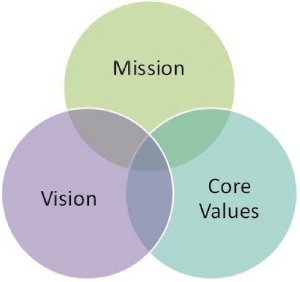Well here we go into a new year! It seems as though I just got used to writing 2013! Now I have to work on 2014! Cheers to cognitive flexibility and learning!
The last discussion of 2013 was about vision statements that answer the question of “Why we are here?” As your organization embraces CARF preparation it is important to understand where the mission statement and core values fit in. So, let’s explore the mission statement and core values.
The mission statement talks about the present and defines how you will get to where you want to be. What you do may change as time goes by but will always tie back to the vision for the organization/program. Doctors may not know it, but they do care about the mission statement because it answers the question, “What do we do?” Many of us are most comfortable with the here and now and have a large investment in what we do as it impacts our day-to-day lives. Put in this context, doctors are usually quick to get involved in a discussion about the organization’s/program’s mission!
With vision and mission statements covered, what are core values and where do they fit in? Core values are several statements that describe the principles that drive the organization’s/program’s internal conduct as well as its relationship to the world. The core values encompass the ethics, principals, and beliefs of the organization/program.
Hmmmm…….adding core values to the mix always confuses me. However, I have found that if I pay attention in the world, many of the companies that we regularly deal with put these principles out to the world. For example, I found myself ordering boots for me during the holidays (when I was supposed to be shopping for my family, what is that about?). The boots arrived from Zappos.com and as I excitedly, albeit somewhat embarrassed, tore open the box, I noticed on the side of the mailing box, “Zappos Family Core Value #8: Do More With Less.”
Core values are probably absolute and unalterable principles such as honesty, respect, and continual self-improvement. I think when we stop to think about what principles drive our organization’s/program’s internal conduct as well as its relationship to the world, they are pretty easy to identify.
Clearly vision, mission, and core values work in harmony. The vision statement describes what the organization/program wants to be in the future, the mission statement describes what the organization/program wants now, and the core values guide an organization’s/program’s internal conduct as well as its relationship with the external world.
If you need help in engaging your doctors with creating the vision, mission, and core values, contact Donna Jo Blake, MD, BRB Consulting, Inc. for physician-to-physician guidance and training. As your doctors take ownership of the vision, mission, and core values of the organization/program, they will become more effective program advocates and leaders.







